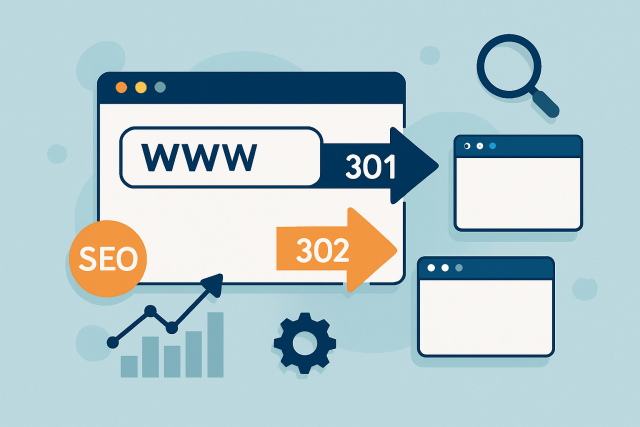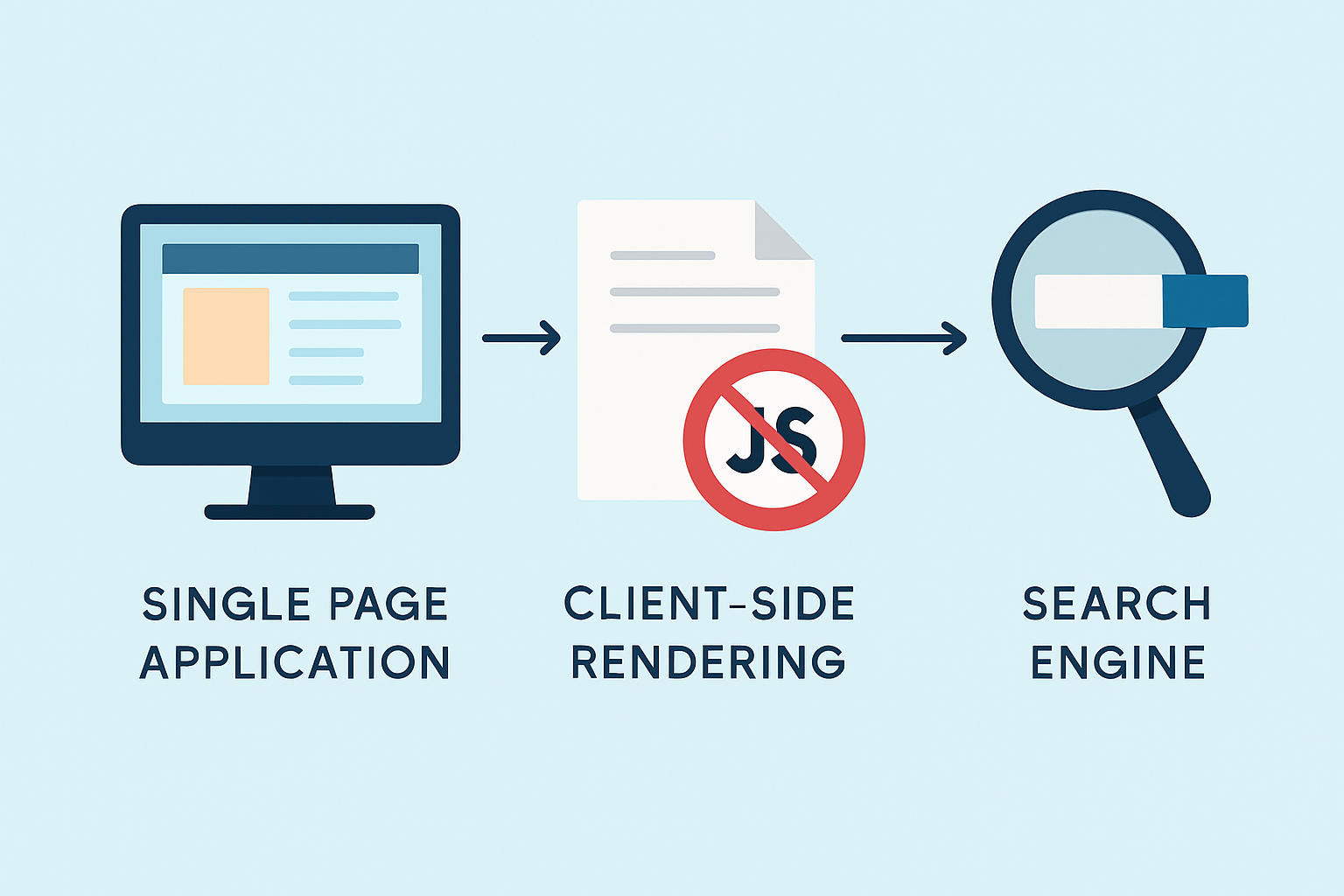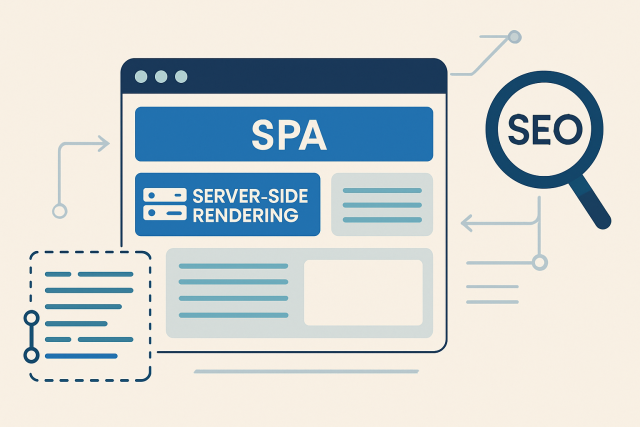
301 Redirects vs 302 Temporary Redirects Explained
Confused by 301 and 302 redirects? This guide explains their differences, SEO effects, and how to us...

Single Page Applications (SPAs) offer a slick, seamless user experience but come with their fair share of SEO headaches. Traditional SEO methods tend to stumble a bit when dealing with SPAs, thanks to their dynamic content loading and client-side rendering quirks.
Single Page Applications load content dynamically on the client side without refreshing the whole page to create a smooth and interactive experience that feels almost seamless. This approach boosts usability but can cause SEO issues because search engines often struggle to crawl or index content loaded via JavaScript. Common headaches are delayed content rendering, tricky URL management, and incomplete indexing.

Diagram showing how SPAs load content dynamically and the associated SEO challenges
Don’t sleep on proper rendering strategies and handling your metadata right because getting these wrong often leads to poor indexing or worse your content being completely MIA from search results.
Semrush’s Site Audit tool crawls traditional websites and SPAs to find issues like crawlability hiccups and JavaScript glitches. It also detects missing or duplicate meta tags that can hurt your search rankings. The tool thinks like Google when indexing JavaScript-heavy pages and highlights SEO challenges unique to SPAs.
Powerful tools to uncover high-traffic keywords, size up keyword difficulty, scope out competitors, and spot fresh opportunities crafted especially for SEO in single-page applications.
Thorough website health checks that sniff out SEO hiccups like broken links, crawl trouble, and duplicate content—custom-tailored for the quirks of SPAs.
Keeps tabs on your site's backlink profile, tracks your link-building progress, and checks out your competitors' backlinks to help beef up your domain authority.
Delivers deep insights into your competitors’ organic keywords, traffic sources, and ad strategies that matter in the SPA market.
Tools to plan, craft, and polish content that follows SEO best practices while keeping an eye on SPA-specific keyword trends.
Customizable reports with clear, eye-catching visuals that make it easier to glean actionable insights on your SPA SEO progress and spot where you need to double down.
API integration for automating data handling and white-label report options, perfect for agencies juggling multiple SPA SEO projects.
An intuitive, neatly organized platform packed with step-by-step SEO tools and guides that welcome users who might not be SEO wizards yet.
Kick off a Semrush audit for your SPA by diving right into a site crawl to uncover any pages playing hide-and-seek or throwing rendering errors your way. Semrush serves up detailed reports that shine a spotlight on the SEO troublemakers.
Log into your Semrush account and fire up the Site Audit tool—it’s the first step on this journey.
Set up a fresh project for your SPA and do not forget to tweak the crawl settings to include JavaScript rendering.
Kick off the audit and hang tight while Semrush scans your entire site, including all dynamic content.
Dive into the audit report with eagle eyes and focus on crawlability hiccups, JavaScript glitches, meta tag quirks, or structured data red flags.
Zero in on the biggest issues that move the needle and team up with your developers to roll out fixes that boost your SEO game.
If you have ever dived into the world of Single Page Applications, you know they can be a bit tricky when it comes to SEO. Luckily, Semrush has cracked some good tips that actually work in the real world. Whether you’re a seasoned developer or just getting your feet wet, these pointers might just save you some headaches and help your app shine in search results. Let’s roll up our sleeves and dig in.
Semrush’s Position Tracking tool lets you keep a close eye on how your SPA pages perform for your target keywords over time. With this insight, you can tweak your SEO strategy gradually to ensure your content updates and technical fixes improve visibility and increase traffic.
Adding structured data like JSON-LD to your SPA can seriously boost your chances of scoring those eye-catching rich snippets in search results. Semrush’s schema markup report is a handy tool that lets you double-check these elements, making sure they’re spot on and complete.
Use advanced techniques like pre-rendering key SPA pages to serve fully rendered content to search crawlers, especially on those all-important landing pages. When it comes to pagination and infinite scroll, a little finesse goes a long way. Think crawlable pagination URLs or handy load more buttons that play nice with SEO indexing.
A thorough look at keywords, digging into search volume, competition, and trends to help you zero in on the best SEO keywords for Single Page Applications.
An in-depth technical SEO audit that spots those tricky issues specific to Single Page Applications like JavaScript rendering hiccups, crawlability, and loading speed slowdowns.
Takes a close look at backlink profiles, focusing on link quality and uncovering chances to build high-authority links tailored for SPA content.
Offers handy tools to optimize SPA content through topic research, SEO-friendly content creation tips, and tracking how your content performs over time.
Provides tailored reports and visual data snapshots that reveal SPA SEO metrics, keyword wins, and your site’s technical health status at a glance.
Supports SEO analysis across languages and regions, perfect for those ambitious international SPA projects.
Packs a wide range of tutorials, webinars, and a friendly support team ready to help users navigating the tricky waters of SPA SEO.
Working hand in hand with developers is absolutely essential when it comes to nailing SPA SEO best practices. Semrush is like your trusty sidekick, helping you keep a sharp eye on SEO health and track progress over time.
SEO in single page applications can face roadblocks like running up against crawl budget limits due to dynamic URLs or shifting states. When content takes its time to load, search engines might skip important bits before indexing. Tracking analytics can be tricky since page views appear without full reloads, so you’ll want to set up custom event tracking. Regular updates and deployments can also harm SEO if URL structures or metadata aren’t aligned.
"Optimizing SEO in SPAs usually means rolling up your sleeves for a tailored audit and keeping a close eye on things over time, since the content changes fast and updates come quick. It’s a bit of a dance to keep that organic visibility steady, but with some care, it’s absolutely doable." – SEO Expert Insights

Confused by 301 and 302 redirects? This guide explains their differences, SEO effects, and how to us...

Learn how SSL SEO not only secures your website but also drives higher Google rankings by boosting t...

Single Page Applications challenge traditional SEO methods. Learn specialized tactics to boost visib...

Discover how HTTPS impacts SEO and user trust with this comprehensive guide covering migration steps...